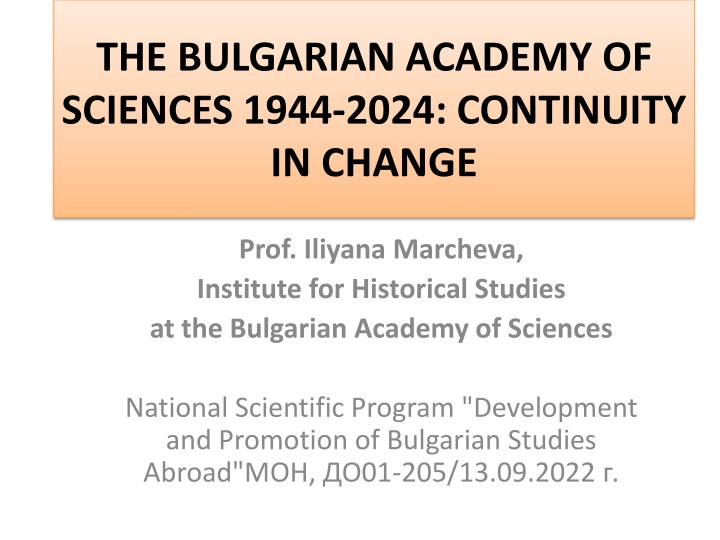
Bulgarian Academy of Sciences: History and Development Overview
Explore the history and evolution of the Bulgarian Academy of Sciences from the 1940s to the 1980s, highlighting key presidents, scientific achievements, and institutional advancements. Learn about its role in technological progress, ideological influences, and contributions to national scientific research.
Download Presentation

Please find below an Image/Link to download the presentation.
The content on the website is provided AS IS for your information and personal use only. It may not be sold, licensed, or shared on other websites without obtaining consent from the author. If you encounter any issues during the download, it is possible that the publisher has removed the file from their server.
You are allowed to download the files provided on this website for personal or commercial use, subject to the condition that they are used lawfully. All files are the property of their respective owners.
The content on the website is provided AS IS for your information and personal use only. It may not be sold, licensed, or shared on other websites without obtaining consent from the author.
E N D
Presentation Transcript
THE BULGARIAN ACADEMY OF SCIENCES 1944-2024: CONTINUITY IN CHANGE Prof. Iliyana Marcheva, Institute for Historical Studies at the Bulgarian Academy of Sciences National Scientific Program "Development and Promotion of Bulgarian Studies Abroad" , 01-205/13.09.2022 .
The Bulgarian Academy of Sciences during the 1940s and 1950s: nationalization after the Soviet model President: the Marxist-philosopher acad. Todor Pavlov ( 1947 - 1962) The Bulgarian Academy of Sciences the highest state scientific institution: Directly subordinated to the Council of Ministers; Research institutes, usually headed by academicians; 7 departments headed by academicians who supervised the institutes. Ideologizing science through the Marxist methodology and the class-party approach. Science must directly serve the "building up of a new society .
The Bulgarian Academy of Sciences in the 1960s: a factor for technological progress and innovative development President: the geophysicist acad. Lyubomir Krastanov (1962- 1968) The Bulgarian Academy of Sciences - a national coordinating center of fundamental scientific research: Development of technical sciences, Physico-Chemistry, Metallurgy, Biochemistry, Energetics, Mathematics, etc. 1969 - 55 institutes and laboratories with 1300 scientists. Breakthroughs: 1962 - the first Bulgarian electronic-calculating machine with program action "Vitosha ; 1965 - the first Bulgarian electronic calculator model Elka 6521.
The Bulgarian Academy of Sciences in the 1970s and 1980s: a leading scientific center President: academician Angel Balevski (1968-1988) 1972-1988 - 9 Unified Centers for Science and Personnel Training Development of the most modern scientific fields: Nuclear Physics, Quantum Electronics, Holography and Optical Recording, Molecular Biology and Genetics, Biophysics, Solar Energetics and New Energy Sources, Space Research, Biomechanics. 1969-1979 - 1300 inventions, 424 implemented into practice. Emblematic achievements: equipment for 2 satellites "Bulgaria-1300", the space greenhouse SVET, the first IMKO personal computer.
The Bulgarian Academy of Sciences in the 1970s and 1980s: a leading scientific center President: academician Angel Balevski (1968-1988) Development of the Bulgarian academic studies: 1972 Institute of Thacology; 1980 Cyrillo - Methodian Research Center; Large academic multi-volume Histories of Bulgaria, of Bulgarian Literature, of Bulgarian Ethnography, Dictionary of the Old Bulgarian Language etc. 1990 122 scientific institutes, laboratories and microenterprises for practical implementation with 5059 scientists.
The Bulgarian Academy of Sciences at the end of the 20th and the first decade of the 21st century: reforms and adaptation Reformes: Decommunization and lustration; Democratization; New supreme governing body- General Assembly of Scientists; Doctoral Training Center (1997). The Bulgarian Academy of Sciences - a dualistic organization of a club of elite scientists - academics and of research institutes, which had already become legal entities. Financial problems and survival: 2009 international audit; 2010 national audit; 2010 45 institutes, 5 specialized units , 3125 scientists, united in 9 scientific fields.
The Bulgarian Academy of Sciences at the end of the 20th and the first decade of the 21st century: reforms and adaptation Entry into the European Scientific Space: 1992-2006 - 262 projects in the framework of various programs worth 27 million euros. 1999 2009 -634th place among 4050 scientific institutions according to the Institute for Scientific Information of the Thomson Corporation. 1994 member of European Federation of National Academies. 2002 - acceptance into the European Science Foundation.
The Bulgarian Academy of Sciences at the end of the 20th and the first decade of the 21st century: reforms and adaptation Presidents: Acad. Blagovest Sendov (1988-1991), Acad. Yordan Malinovski (1991-1996), Acad. Ivan Yukhnovski (1996-2008), Acad. Nikola Sabotinov (2008-2012), Acad. Stefan Dodunekov (2012)
The Bulgarian Academy of Sciences in the second decade of the 21st century: a leading scientific and cultural center Presidents: Acad. Stefan Vodenicharov (2012-2016) and Acad. Julian Revalski (2016-2024). The Bulgarian Academy of Sciences a leading scientific center: Over 50% of the scientific production in peer-reviewed and indexed journals; The H-index for citation: in 2019 - 182, in 2022 240. European Research Council (ERC) funding for 9,9 million euros project" LEVIATHAN of the Institute of Ethnology and Folklore Studies. Coordinator of 23 of the 50 projects of the National Roadmap for Scientific Infrastructure (2020 2027).
The Bulgarian Academy of Sciences in the second decade of the 21st century: a leading scientific and cultural center The Bulgarian Academy of Sciences - a leading center of expertise: 2008 - Regional academic centers; 2015 - the most powerful supercomputer in the Balkans, the Avitohol. 2023 - Maintaining 160 patents, utility models and registered new plant varieties.
The Bulgarian Academy of Sciences in the second decade of the 21st century: a leading scientific and cultural center The Bulgarian Academy of Sciences cultural and educational centre : Doctoral students: - in 2021 88; - in 2022 122; - in 2023 - 115. Scientific forums and celebrations of important national events or personalities.
THE BULGARIAN ACADEMY OF SCIENCES 1944-2024: CONTINUITY IN CHANGE Thank for your attention






















